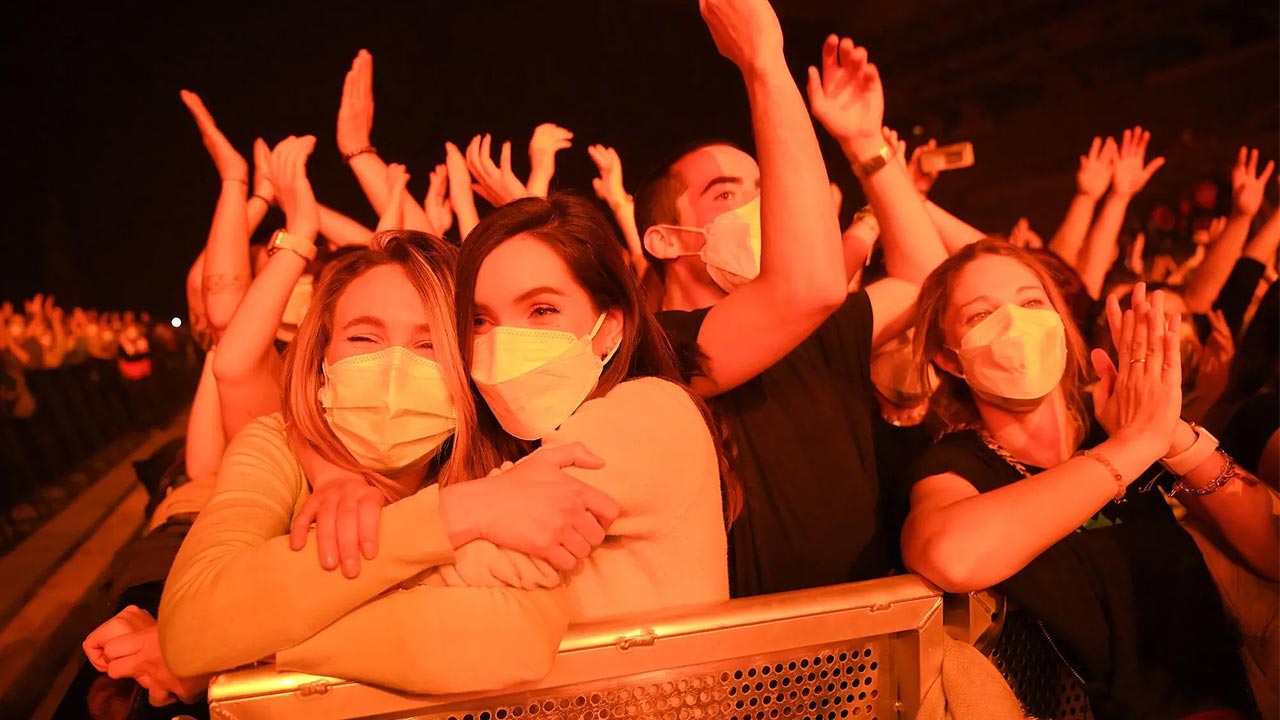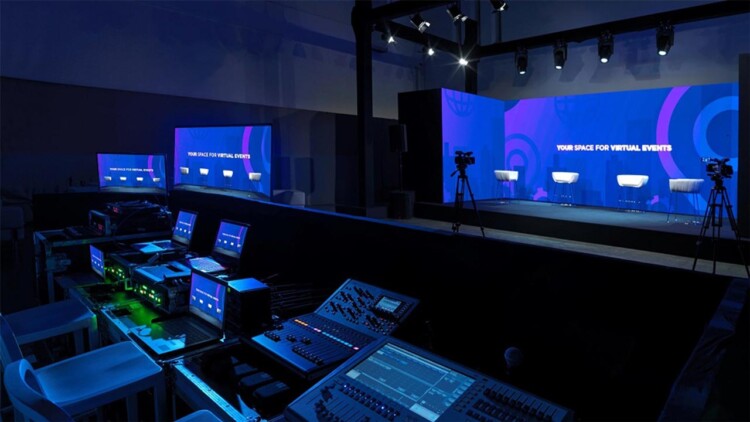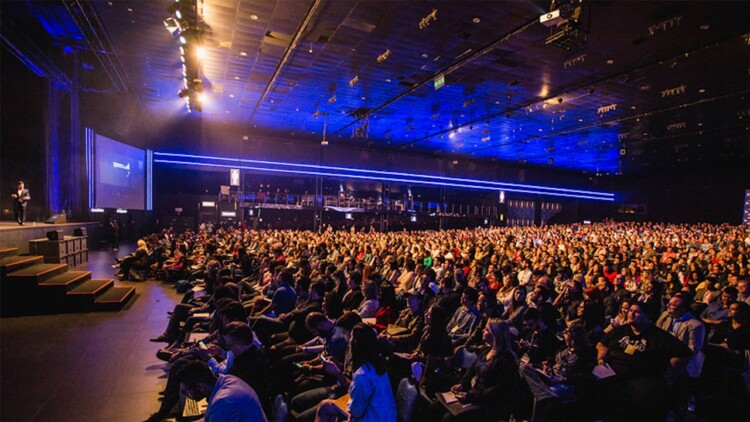After years of virtual events, the return of in-person events is just around the corner. We can feel it; can you? Rather than postponing, focus on the health and safety precautions in this article.
For event planners, marketers, and attendees alike, it’s been a tough couple of years. We all miss the rush of the in-person experience: grabbing a fresh coffee in the morning, running into people you haven’t seen in ages, and networking in the lounges … even the struggle of trying to find a quiet place to take a call.
In-person events are truly irreplaceable, and people are eager to get back to those face-to-face interactions. Over the past two years, event planners have become incredibly innovative in their mastery of virtual events. Although the merits of virtual events are many, it was never a question of if in-person events would come back, but rather when in-person events would come back.
As we look to the future of hybrid and in-person events, the safety of everyone involved is undeniably a top priority. The question on everyone’s mind is how to minimize the risk for our attendees, partners, and staff. It will be an adjustment, and none of us will master it overnight, but this guide will help give you some direction so you can feel confident in planning a safe event.
11 Safety Measures To Ensure In-Person Event Success
Aside from the health benefits, these safety measures will also determine how you are perceived by your attendees, your speakers, your partners, and your own team members.
We hope that the below safety will help you avoid a similar experience. However, we also encourage you to check out the CDC’s Guidance for Organizing Large Events and Gatherings (or the guidelines of your local health authority) to make sure you’re compliant with the health regulations in your region.
1. Pre-Event COVID-19 Testing
The most important thing you can do to ensure the safety of your attendees is to ensure that no one actually has COVID-19. The best way to do that is by requiring proof of a negative COVID test or proof of vaccination. You can request proof via email or in-person when they check in. By requiring vaccination and negative test results, you can make sure everyone feels more comfortable at your event, from your attendees to your employees.
2. On-Site Health Checks
Another great option is to offer on-site screenings. This way, there’s no waiting period between their negative test and their arrival on-site. There are many companies that offer on-site testing nationally, such as TrueCare24.
If you want to go a step further, companies like Healthe offer UVC222 devices that can be placed at entry points and outside meeting rooms. Guests walk through the device which sanitizes the person, their clothing, and belongings.
3. Masking
According to the CDC, masks are one of the best ways to stop the spread of COVID-19. They are also an easy way to ensure everyone on-site feels more comfortable. You can offer on-site PPE, such as masks and gloves, as well to make sure that anyone who does not have a mask or loses their mask has access.
Masks are also a great opportunity for branding. You can create branded masks with your logo, or you can use this as an opportunity for your event sponsors to get their brand in front of your audience.
4. Sanitizer Stations
Luckily the days of sanitizer shortages are behind us. As you plan your on-site experience, you should have hand sanitizer readily available throughout the space. There are also many options, from individual sanitizers you can place at each seat to touchless stands you can place all around the venue.
Sanitizers are another way to promote your brand or your sponsor’s brand. You can create custom logos and designs for both sanitizers and stations which is another COVID-friendly and useful giveaway for your attendees.
5. Social Distancing
Social distancing will be one of the long-lasting changes to our daily lives. For on-site events, one of the biggest changes will be floorplans. No matter which seating you choose (rounds, classroom, U shape, or theater) you will have to take into account the distance between attendees. Where eight people used to be able to fit at one round, you might want to limit it to three or four people at each table.
Cort Events offers a great example of space planning by using a 6-foot-to-scale grid to help you create a socially distanced floor plan. They even suggest a safe square footage per attendee to help you calculate how much space you will need to host a safe in-person event.
In addition to your meeting format, you can plan strategic lounge and stage sets. By placing furniture intentionally, you make it easier for your guests to keep a safe distance apart without any guesswork. Common areas should also have enough space for attendees to keep 6 feet apart.
6. Designing Clean Spaces
Another way to ensure your guests have a safe on-site experience is to include increased cleaning and air filtration measures and then communicate those measures to your attendees. Cort Events provides another great example of using green or red indicator cards to let guests know if a seat or area has been cleaned between uses. The more transparent you are with your cleaning and safety measures, the more comfortable your attendees will feel.
7. Contactless Experiences
Even those who are comfortable attending in-person probably want to avoid touching any unnecessary surfaces. Using touchless technology will help you minimize the risk of spreading germs.
Consider offering touchless payment options on-site like Apple Pay to reduce physical contact with surfaces like screens that easily store germs. You can also create a contactless entry experience by using one of the many technologies that allow for digital scanning.
Depending on the on-site solutions offered by your event technology provider, you may be able to send out mobile or virtual tickets ahead of time that can simply be scanned off of an attendee’s mobile device. Another option is to use on-site badge printing which can be done in seconds and reduce the wait time in line.
8. Vendors, Sponsors, and Staff
Don’t forget to use your own resources to help create a safe and comfortable environment, your on-site team is there to help. Designate specific team members to handle certain responsibilities the day of your event. For example, one person should be in charge of emergency and important communications with your attendees and the rest of your team. Other team members can actively monitor the attendees to make sure everyone is following the event safety guidelines.
9. On-Site Food and Catering
If you have a longer event and want to offer on-site breakfast or lunch, there are a few precautions you can take to reduce risk. If you have a buffet or served lunch, make sure your venue has sneeze guards in place and try to use servers to dish out food instead of letting attendees use shared serving utensils.
Another great alternative is a grab-and-go option which the venue can prepare ahead of time and give to attendees pre-packaged. This way, there’s no need to set up a buffet and no risk of exposed food because each person has their own pre-assembled meal. If you go this route, you also ensure you have plenty of food for attendees with food allergies or special dietary restrictions. It’s a win-win!
You can also dedicate an hour for lunch for attendees to go grab food wherever they’re comfortable. Some attendees might bring their own food and want to find a spot outside to eat, while others will want to find an outdoor dining option.
10. Attendee Experience
One of the best ways to return safely to in-person events is to give attendees all of the necessary tools needed to feel comfortable and at ease at your in-person event. For example, CES 2022 offered attendees three stickers to put on their nametags to indicate their level of comfort with handshakes and touching:
- Green: I’m okay with handshakes.
- Yellow: I’m okay with elbow and fist bumps.
- Red: No touching, I’m happy just waving “hello.”
11. Exit Procedures
Although the beginning of the day is usually a steady flow from your early risers to the latecomers, events usually end in a mad dash to the elevators. In order to avoid the crowded stampede at the end of the day, make sure you have clear exit procedures in place.
This might mean dismissing people by groups or using the floor markers to keep people at a safe distance while they wait for the elevator. Whatever you choose to do, make sure your attendees are made aware of the procedures and can plan accordingly.
How To Communicate Your Event’s Safety Measures
On-Site Signage
The best way to communicate with your attendees is through on-site signage. Ample signage is key to making sure your guests know what’s expected of them and what steps you’re taking to ensure their safety.
If you have standing hand sanitizer stations, consider placing signs next to them so attendees can easily find them. And for social distancing guidelines and reminders, you can create beautifully designed posters and decals to place on windows and walls. If you’ve created a safety guide, you can print that out as well and put it in high-traffic areas like the check-in or lounges.
The Empower Conference, for example, held a hybrid event and created branded signage placed throughout the space.

Signage is a dual opportunity to create a sense of comfort and transparency with your attendees and brand the space with either your brand or your sponsors’.
Pre-Event Communication
Pre-event communication is an essential part of your overall event safety strategy because it helps prepare your attendees and manage expectations. There are a number of ways you can communicate with your guests even before they arrive on site. Below are some examples:
- Help them visualize the space: You can send your registrants a copy of your venue layout and seating plans. If you have a more formal event with assigned seating, you can include that information so they have all of the details of what to expect. Put yourself in the mindset of your attendees and think about what you would want to know going back to in-person events.
- Keep them in the loop: It’s also important to communicate any changes or updates on your event safety plan or venue gathering restrictions. As the CDC continues to monitor the situation and release their recommendations, make sure you are keeping your registrants up to date throughout the entire process leading up to your event.
- Make the virtual option clear: We’re now living in a hybrid events world. While nothing can beat in-person attendance, have a plan in place for communicating your event’s virtual option to registrants and prospective attendees. What are the advantages of attending in-person? What will make virtually attending worthwhile for those who would prefer that experience?
Safety Guide
A safety guide is a document that clearly outlines the steps you’ve put in place to ensure your attendees, partners, and staff are as safe as possible. For example, CES 2022 featured a very thorough Health Protocols guide on its website and ADAA 2022 also has a very thorough and downloadable guide.
Remember: This health and safety guide should include everything from what you expect from your attendees to what they can expect from you. Here are some tips:
- Check-in process: Be sure to include detailed information about the check-in process like whether you will be requiring proof of vaccination/negative results and what the on-site check-in experience will look like.
- On-site precautions: This guide should also include any on-site precautions you are taking to keep your attendees safe, from sanitizers to readily available PPE. It should also clearly communicate what you expect of your attendees on-site.
- Mask policy: Make sure your guests know whether they will be required to wear a mask and practice social distancing once they arrive at your venue.
- Accommodation clause: It’s a good idea to also include a reasonable accommodation clause. Be prepared that some attendees may have apprehensions about wearing a mask or practicing COVID-safe behavior, and you owe it to all of your attendees to create a safe environment. If that means that mask-exempt guests will be asked to leave, then that’s something you’ll want to note in your safety guide.
- Sharing policies: You can send out your safety guide ahead of time to anyone who registers so they have ample time to review your policies and even get in contact with you in case they have any questions or concerns about what to expect from the on-site experience.
Contact Tracing
Contact tracing can help alert people who may have been exposed to COVID-19. It’s a great way to ensure your attendees feel comfortable on-site and can help keep you protected legally. For example, at PCMA 2022, the event team was able to keep tabs on positive cases and release that information to the public in order to show trust and transparency.
Contact tracing is an important part of tracking and slowing the spread of COVID-19 and protects you and your guests. It also speeds up the process of identifying potential exposure and therefore helps to avoid any further spread.
4 Keys To Safely Hosting In-Person Events
Hybrid events will be the vehicle by which organizers can safely bring back the in-person experiences we’re all craving. Keep in mind is that your guests will have different comfort levels with attending in-person events.
Although many attendees can’t wait to get back to in-person, others might not feel as comfortable or may still be unable to attend because of a disability, caregiver responsibilities, or a number of other possibilities. That’s why the hybrid model is the best approach to addressing the needs of your entire audience. As we navigate our way to a new normal, the most important goal to keep top of mind is event safety.
There are a few key ideas to keep in mind as you continue to build out your live event safety strategy.
- Be flexible: This past year has shown us just how agile the events industry is, and continuing to be flexible will be key moving forward. There are still many unknowns and truthfully nothing is certain. Be prepared to make changes to your event safety plan and embrace the agility of our industry.
- Have a backup plan: Event planners always have a backup plan. Perhaps you have even more than one. Whether you have a plan B or a plan for every letter of the alphabet, we hope for the best and plan for the worst. Having a backup plan goes hand-in-hand with being flexible. Given the unpredictable nature of the pandemic, it’s important to give yourself options and not be pigeonholed into one plan.
- Over-communicate: Communication is key across the board, but in uncertain and changing times, it’s even more crucial to make sure we are all on the same page. Although you may be hesitant to bombard your guests with emails, they will appreciate being kept in the loop especially where their safety and wellbeing is concerned. You should also practice over-communicating with your team and venue as well to stay constantly aligned.
- Follow CDC and local guidelines: The best source for information and updates around live event safety and preparation is the CDC. They are continuously releasing new information and guidelines to help everyone stay safe. Make sure to check the CDC’s website often throughout your planning process, especially as it gets closer to your hybrid or live event.
Key Takeaways: How To Keep Everyone Safe at Your Next Event
The long-awaited and triumphant return of physical events is already here — just in smaller doses than anticipated thanks to the continued appearance of COVID-19 variants. There are ample precautions to take to protect both your event stakeholders and your brand.
Fortunately, it’s now easier than ever to be flexible with your event program. Hybrid event software now offers organizers the flexibility to power in-person experiences, amplify these experiences to virtual attendees, and pivot to a fully virtual experience on the fly.
Author: Rachel Rappaport
Source




